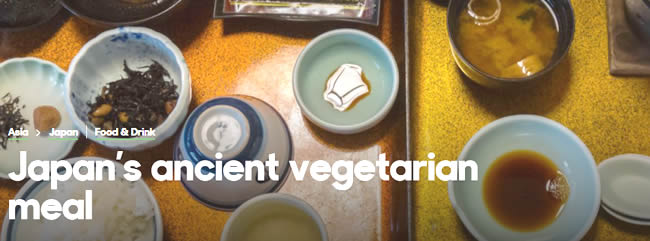先日から「Japan’s ancient vegetarian meal -「日本古来の菜食料理」を読んでいます。

・「日本古来の菜食料理」(1)
・「日本古来の菜食料理」(2)
・「日本古来の菜食料理」(3)
・「日本古来の菜食料理」(4)
Drawing significance from the five phases of Chinese Philosophy known as wuxing, the number reflects the cyclical balance needed in nature and society.
五行思想として知られる中国哲学の五段階の意味を導き出すと、その数は自然と社会に必要な周期的バランスを反映する。
wuxing「五行、五行思想、五行説」。
In shōjin ryōri, this applies to colour, flavour and technique:
精進料理では、これは色、味、技術に相当する:
the goshoku (colour) of white, black, red, green and yellow;
五色は、白、黒、赤、緑、黄色、
the gomi (flavour) of sweet, sour, bitter, salty and umami;
五味は、甘味、酸味、苦味、塩味、旨味、
and the goho (technique) of simmered, fried, raw, steamed and grilled are all required elements.
そして五法(技術)は、煮る、揚げる、生、蒸す、焼く、これら全てが必須の要素だ。
As well as guiding nutritional balance, the rules are designed to appeal to the five senses,
この法則は栄養バランスの指針としてだけでなく、五感に訴えかけるように設計されており、
inspiring the diner to notice and value each ingredient as well as the care taken to prepare it.
食す人が各要素と調理の手間に気づいて、それを尊ぶように促す。
Before eating even begins, this is done through the chanting of the five Zen reflections, encouraging monks to be grateful, aware of their imperfections, strive to improve upon them, eat for good health and to fulfil their obligations.
それは食事の前に、感謝の心を持ち、自らの不完全さを認識し、改善するべく努め、健康のために食事をし、責務を果たす事を僧侶に促す五観の偈(ごかんのげ・仏の功徳をほめたたえる詩)を唱えることから始まる。
obligation「義務、責任、拘束、恩義、義理、契約書、債券、債務、負担」。
Passed from chef to diner, the meal forms a bridge, as Fujii explained:
藤井さんが言うように、作り手から食べ手に供される食事は架け橋となる、
“it’s a spiritual pursuit, but also it’s an opportunity for you to connect with other people.”
「それは精神的な探求であり、他の人々とつながる機会でもあるのです。」
5つの各要素を全て満たした献立、しかも動物性食品を使わずにとなると、支度はとても手間がかかる・・・調理そのものが修業という意味が、なるほど分かる気がします。
肉や魚をどーんと出すのは、見た目の豪華さに反して実はあまり手間ではなく、むしろ食べ応えはあまりない副菜の野菜料理の方が面倒だったりします。
なので普段料理をする人であれば、きっと精進料理の手間のかかり具合にはすぐに気づけそうな気がします(笑)。
まあどんな料理でも、作ってくれるだけでも有難いものですホント。
理由は単純明快!「少ないコストでしっかり楽しく学べるから」。
私自身の経験(高機能でビックリ)をびっしり書いていますので、良かったら読んでみてください。
下のバナーからどうぞ!






